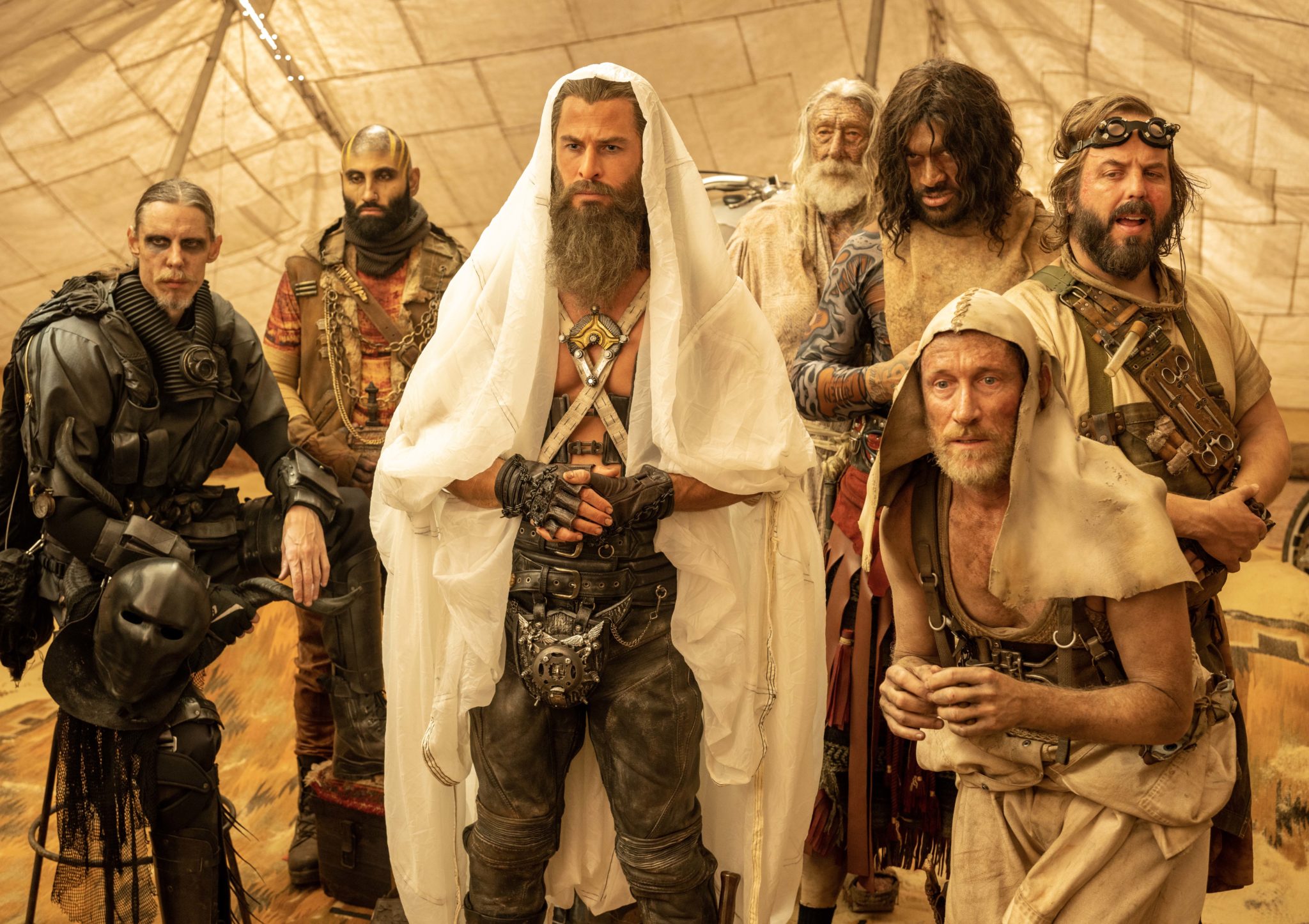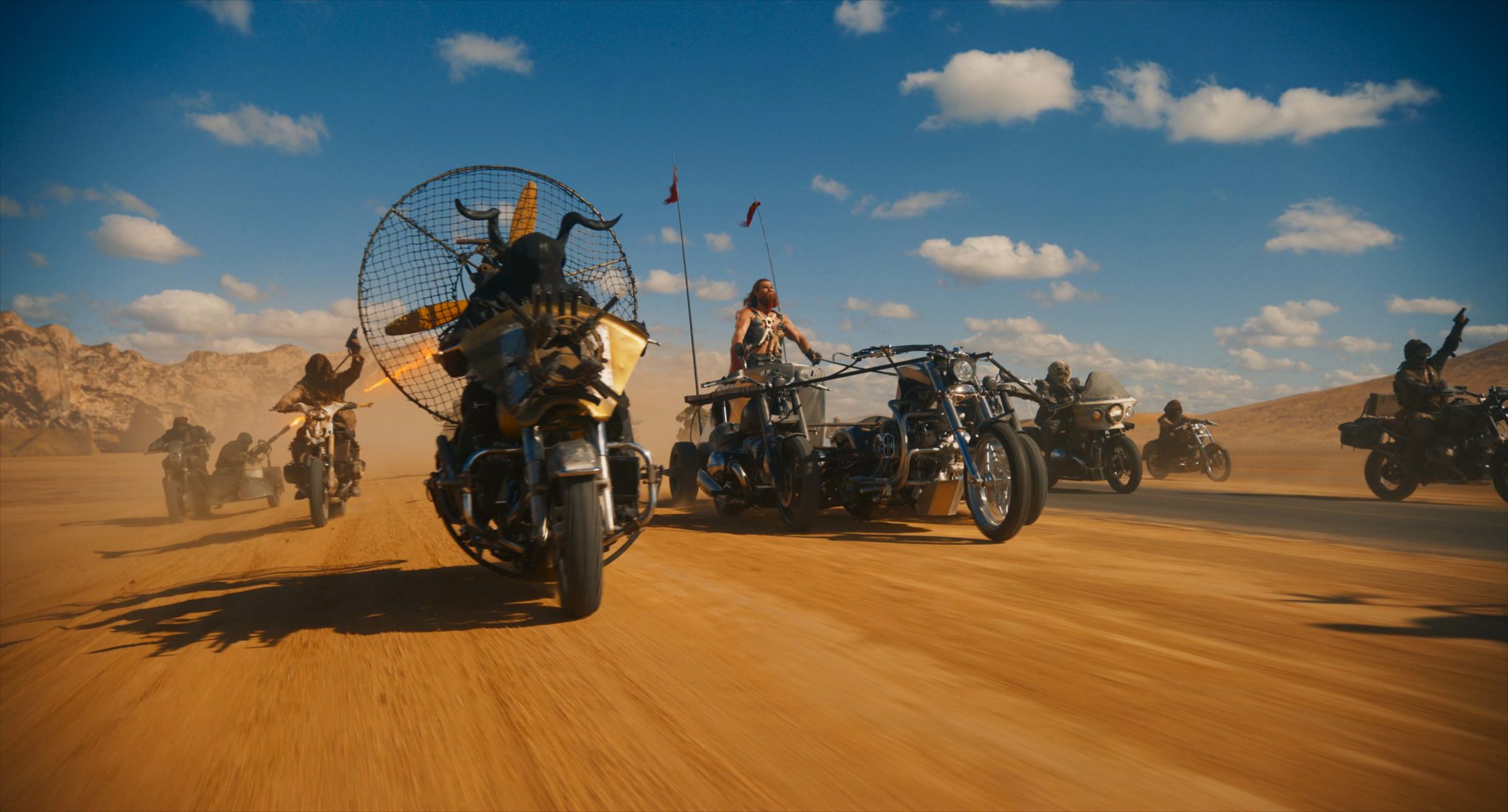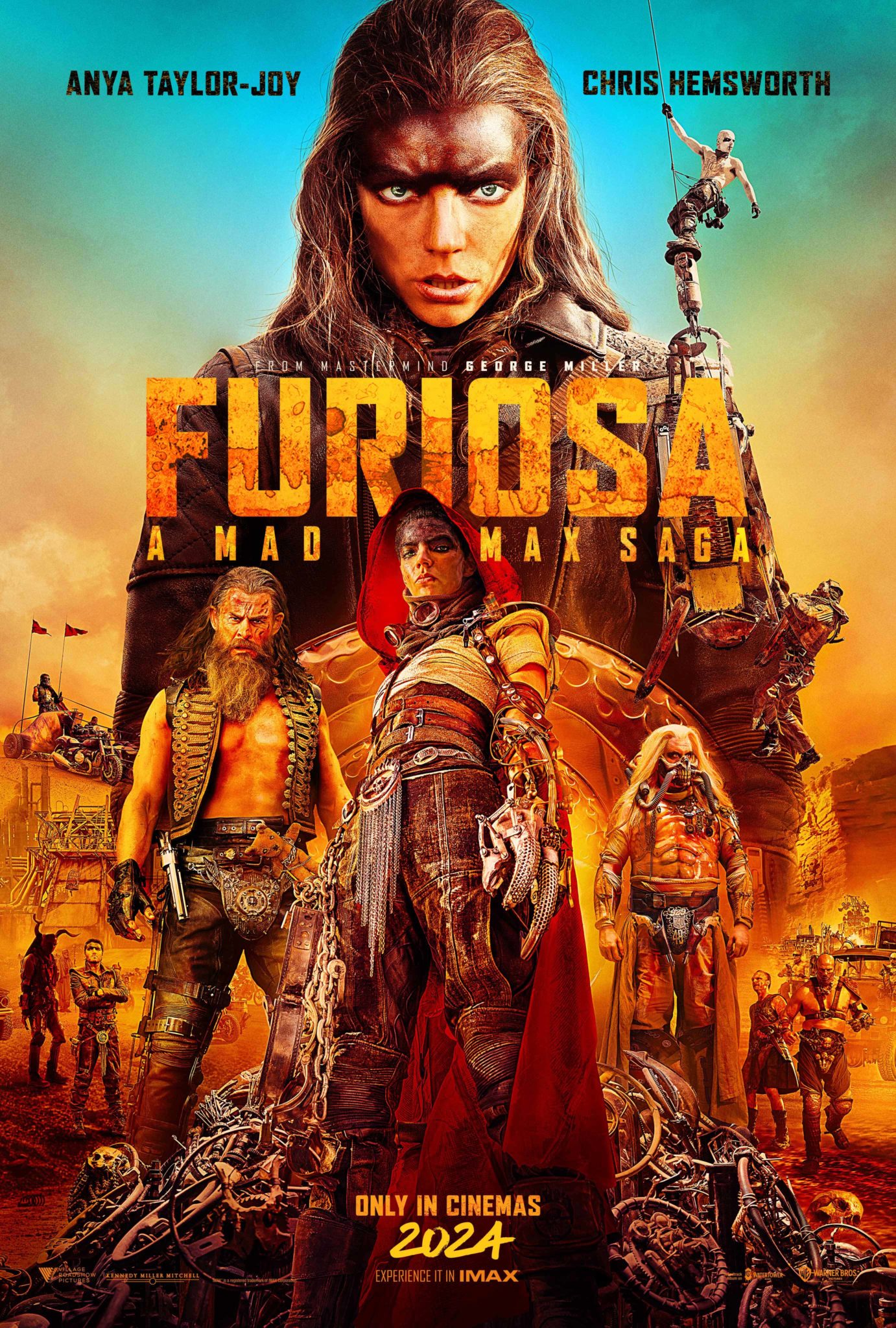- Film And TV
- 23 May 24
Anya Taylor -Joy: "I think this cliché of feminine passivity is getting quite exhausting, because you can’t gender us in that way.”

Director George Miller, and stars Anya Taylor-Joy and Chris Hemsworth, discuss the latest must-see instalment in the Mad Max saga, the rip-roaring Furiosa.
If you read enough politicised media, you may be increasingly concerned that the world will become a lawless dystopia fairly soon – but fear not! Director George Miller’s long-awaited prequel Furiosa: A Mad Max Saga is ready to show us how we can become fierce war captains, ready to survive any foe, environmental or human.
Furiosa is the fifth entry in Miller’s Mad Max franchise and a prequel to Mad Max: Fury Road, following a young Imperator Furiosa as she comes into her own. After being taken away from the Green Place of Many Mothers as a child, she is thrust into a sinister and violent world. The film follows her transformation into a formidable survivor, learning to fight, master the gas-guzzling war machines and protect herself against the sociopathic Dementus, played by Chris Hemsworth.
In 2015’s Mad Max: Fury Road, Charlize Theron’s Furiosa instantly became iconic, with the actress not only displaying fearlessness when it came to stunts and fight choreography – skills she has also displayed in films like Atomic Blonde and Aeon Flux – but also capturing the strength and buried vulnerability of the character. Theron and audiences alike were keen to see her return, but as Furiosa took nearly a decade to reach our screens, Miller ultimately decided to cast Anya Taylor-Joy as the younger version of the character.
Unlike some of the other chapters in the Mad Max franchise which cover a couple of days, Furiosa is a real odyssey, following the character from ages 10 to 26, and Miller felt that a younger actress was needed. Theron has expressed her disappointment at not being involved, comparing letting go of Furiosa as a grieving process, but the actress has also wished Miller and Anya Taylor-Joy well. For Miller, recasting was a tricky decision, based on not wanting to rely on distracting, de-aging technology as seen in Martin Scorsese’s The Irishman.
“We’re very proud of what she did,” says the Australian director, who didn’t know if he would find anyone to replace Theron until he saw Taylor-Joy in Edgar Wright’s Last Night In Soho. “The big thing was to find somebody who can capture her demeanour, her persona, and she had very similar qualities. They’re similar in their approach to the work as actors – they’re very determined and hard working. Both of them from an early age were accomplished in ballet, and I’ve noticed dancers usually have a high level of motor and neurological skills, which adapt very well to acting.”

Anya Taylor-Joy speaks in reverent tones about Theron’s original performance.
“I feel very lucky to have fallen in love with this character through Charlize’s interpretation,” she enthuses. “Her performance was absolutely flawless and left an indelible mark not only on my soul, but on a lot of people’s souls. Especially at the time, because you hadn’t really seen women on screen in that way. It really shepherded in a new era. I feel lucky that this world was so richly envisioned, and that I felt such a strong connection to it when I was presented with the script. I really felt it was my responsibility to protect her at all costs and hopefully I’ve done a good job.”
Taylor-Joy is known for playing strong, complex female characters, and has expressed her frustration with how many male writers present women as soft and delicate. She has articulated a desire to see more female rage and resourcefulness onscreen – and luckily, Furiosa embodies those qualities.
“I really do have a thing for feminine rage,” laughs the 28-year-old. “It’s something I find myself discussing with male directors, not in the sense of promoting violence, but I do think this cliché of feminine passivity is getting quite exhausting, because you can’t gender us in that way. If you hurt us, we’re going to react in some kind of a way.
“What was interesting about this film is George very accurately pointed out to me early on that nothing about the wasteland invites any kind of emotionality, because that will naturally lead to you being dead. So he had a very strict idea of what Furiosa’s ‘war mask’ should look like, which really only left my eyes visible for a large portion of the film, as an armour. What was interesting was playing with the idea of where she gets to let go, and where she has to push it all down.”
Taylor-Joy explores the idea further. “It’s been pointed out to me that I have a bit of a history of playing intense women in very suppressive worlds,” she continues. “I think these worlds are historical representations of a time when women were more suppressed. But they’re also just representative of how women have been suppressed for so long. It’s the resilience in women that I find really interesting.
“Furiosa has a resourcefulness that I find very impressive. She’s resilient, patient and resourceful, and just has this absolute refusal to be buried. She gets buried time and time again, and refuses to stay down which I find very admirable.”
Chris Hemsworth plays the film’s antagonist, the brutal, insane and charismatic Dementus, who is a product of his unforgiving environment and rules with unrelenting cruelty. Known for playing the superhero Thor in the Marvel Cinematic Universe, the actor embraced the opportunity to play a villain.

“This is a movie about what people are like when they’re pushed to these kinds of extremes,” he says. “The extremity of survival really applies to both of these characters. They go about it in polar opposite ways, but they are both reacting to this incredibly inhospitable environment, both trying to survive. Dementus is certainly the byproduct of a violent, abusive world.
“He hasn’t been sheltered from the harsh reality that life is short and you can only try to get through the next hour. Some of his madness comes from that desperation, I think. It’s interesting to continually put yourself in the position of asking ‘What would I do to survive? What would I do to protect those I love? How far would I go?’ That’s what people are faced with having to consider.”
For Hemsworth, shooting in his home of Australia with Miller was a dream come true.
“Growing up as an Australian, Crocodile Dundee and Mad Max were our cinema,” he reflects. “And then I guess Strictly Ballroom later on. But Mad Max had such a huge influence on me. I have very vivid memories of watching Mad Max, and the discussions I’d have with my dad afterwards about the motorbikes and cars – he raced motorbikes and knew a lot of the stunt riders in the films. So it was an absolute dream come true to be a part of it many years later.
“After my first day on set, I’d done a scene that was quite heavy with a lot of dialogue and so on. I was a bit nervous and shaken, questioning everything. One of the actors, Angus Sampson – who also grew up in Australia – grabbed me and he shocked me. He said, ‘Chris, you’re in a Mad Max movie. We’re in a Mad Max film.’ And I was like, ‘Oh my God, you’re right. We are.’ So that really helped ground the joy that we should be experiencing in the film, and the opportunity we had. So it was great, really special.”
What added to Hemsworth’s experience on set was Miller’s tradition of hiring a lot of people from different backgrounds, many of whom hadn’t acted before.
“There’s such an eclectic group of people on the set, specifically with the gang of bikers surrounding my character,” enthuses Hemsworth. “One guy was an ex-Hell’s Angel straight out of prison, who discovered acting while inside. Then you have seasoned theatre actors and people who have been in the industry for a long time. There was such a mash-up of personalities. I would assume it was strategic on George’s behalf, to assemble people who really complemented one another.
“Whether they had one line in the movie or a few, they hold such presence, because across their entire being is a wealth of real experience. I became really close with a lot of those guys and was fascinated by their stories. I felt rather insignificant when telling any of my tales because these guys, whatever drama we’ve seen onscreen, they’ve lived it.”

Hemsworth further notes how exhilarating the cast found filming Furiosa.
“Something really beautiful about coming onto a film with such lore surrounding it, is that everyone’s excited to be there,” he says.
“Regardless of your history and where you come from, we were all unified by this idea of, ‘We’re all here and gonna go for it. And this is fun.’ There were some individuals the world has certainly turned its back on, and weren’t given a second chance until George said, ‘I believe in you.’
“There were people who had a violent past, who had made mistakes, but there was such a redemptive quality and George saw something in them. Honestly, you watch these individuals grow and listen throughout the process, because finally someone saw them. They were acknowledged and listened to and heard, and that was a real lesson for life in general.”
While Miller’s 1979 Mad Max might have defined Australian cinema, Fury Road defined a new standard for modern action films. The movie was universally acclaimed for not only its lead performances, but also its thrilling, kaleidoscopic action and bravura storytelling. Miller said he didn’t feel pressure to live up to that film, per se, but rather to challenge himself to do something different within the same world.

“One of the worst things to do is to exaggerate what you did before, but there are certainly elements similar to the kinetics of Fury Road,” says the director. “But the exercise of that film was to see how much of the exposition and backstory we could tell on the run and make the story coherent, so it’s not just a lot of noise and colour. In this case, the biggest thing was to attempt to tell the narrative over the long period of time, and find a way to manage all of that while including the familiar tone of Fury Road.”
Miller is known for his action, but he’s also incredibly committed to creating stories with deeper emotional resonances. He hopes this new chapter of Mad Max will capture audiences’ imaginations.
“Some people argue that the Mad Max movies are like Westerns on wheels,” says Miller. “But we tell these archetypal stories – fairytales and fables – in every culture, because we live in a complex world and are trying to understand it. The Mad Max world is set in the future, but it’s like looking forward into the past, and the way we go back to pretty timeless human behaviours.
“The way we organise hierarchies; the way we’re all subject to the cruelties of the world; and the way we all have to navigate potential moral injury in everyday life, no matter what we do. That’s one of the reasons we tell these stories.”
Miller compares Furiosa to a classic Greek Odyssey tale, but also says it overlaps with traditional Indigenous Australian narratives.
“In the First Nations culture that go back, some people would argue 50,000 years, they are continuous,” he says. “Particularly in the centre of Australia, their narratives aren’t just entertaining stories, they’re stories that help explain the entire universe to a culture that’s basically nomadic, because it couldn’t be agrarian. There were no crops or animals, it was mainly desert.
“But they understood the earth and the stars and how to survive in this wasteland, through their stories. And through their performance, dance, art and painting. The stories became very powerful. That was really striking to me – how no matter where we come from, or how we experience the world, we tell stories about it.”
• Furiosa: A Mad Max Saga is in cinemas from May 24.
RELATED

- Film And TV
- 06 Jul 22
Watch the first trailer for crime drama Amsterdam, featuring Taylor Swift

- Film And TV
- 28 Oct 21
Five Reasons Last Night in Soho is a Must See

- Film And TV
- 30 Aug 21
Anya Taylor-Joy to reunite with 'The Witch' director for 'Nosferatu' remake
RELATED

- Film And TV
- 20 Apr 21
Paul Mescal earns 'Best Breakthrough' nomination at MTV Movie and TV Awards

- Film And TV
- 09 Mar 21
The Queen's Gambit stage musical in the works, based on 1983 novel

- Film And TV
- 03 Feb 21




